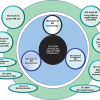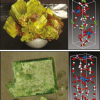Praveen C. Ashok* and Kishan Dholakia
SUPA, School of Physics & Astronomy, North Haugh, University of St Andrews, St Andrews, Fife KY16 9SS, Scotland, UK. E-mail: [email protected]
Introduction
Over the last century, optical spectroscopic techniques have played a crucial role in expanding our understanding of the chemistry behind various materials. Amongst all the spectroscopic techniques, Raman spectroscopy possesses a unique identity due to its specificity, high information content and ease of sampling. Although a weak phenomenon, advancement in detector technologies and efficient spectrometers has driven the wider application of this technique over the last two decades. Micro-Raman spectroscopy is a popular technique in which Raman spectroscopy, combined with a microscope, is used to probe a variety of materials, including cells.1 However, the footprint of a typical micro-Raman system and the alignment requirement have, to date, made it impractical for portable applications.2 Fibre-optical Raman probes have emerged as a solution to realising portability and ease of alignment, especially as the technology has advanced to achieve hand-held portable spectrometers and lasers for Raman spectroscopy.3 Despite these advances, fibre-based probes may not be the best choice to record the Raman spectrum from a small amount of an analyte. A solution to this can be found in lab-on-a-chip (LoC) techniques, which aim to probe and characterise a small amount of a sample of the order of micro-litres or nano-litres.4,5,6
Optofluidics refers to the combination of optical techniques with LoC technology. The marriage of LoC technology with Raman spectroscopy has resulted in our recent work in developing an optofluidic technique called waveguide confined Raman spectroscopy (WCRS). This is a completely optical alignment-free microfluidic chip in which the Raman and fluorescence signature of an analyte (volume of microlitres) can be recorded.7 The WCRS architecture is realised with a microfluidic chip within which we embedded optical fibres in such a way that maximum collection efficiency of Raman scattered photons was ensured while discarding the majority of the unwanted background signals from both the substrate of the microfluidic chip and the optical fibres. The WCRS microfluidic chip may be considered as an optofluidic analogue to a fibre-optic Raman probe. The use of soft-lithography-based fabrication and use of standard optical fibres makes this device at least two orders of magnitude cheaper than commercially available fibre-optic Raman probes.
This WCRS device has been used in a variety of applications and was combined with other microfluidic functionalities. The WCRS device was used in various applications, ranging from bio-analyte detection to a detailed analysis of single malt Scotch whisky.8 For this latter application, pertinent to the food and drink industry, a 20 µL whisky sample was used and both Raman spectroscopic and fluorescence spectroscopic information could be obtained. From these signatures, the alcohol concentration of the sample was predicted to an accuracy of 1%, along with additional information to classify the sample based on its inherent aromatic features. Such an analysis could provide a key step in identifying counterfeit samples. This article briefly describes the scope of optofluidic devices that can be implemented using the WCRS technique.
The WCRS device architecture
WCRS is a simple but powerful optofluidic architecture in which an embedded optical waveguide enables efficient delivery of the excitation beam and collection of Raman photons in a completely alignment-free manner. The WCRS architecture was realised in a polydimethylsiloxane (PDMS) chip fabricated using soft-lithography. Two optical fibres were embedded in a leak-proof manner into the chip with a pre-defined fibre insertion channel in the chip. One fibre delivered the Raman excitation beam into the chip and the other fibre collected both the Raman and fluorescence signals from the sample. Aligning the two fibres in an orthogonal geometry minimises the fluorescent background originating from the excitation fibre, as shown in Figure 1.

WCRS chip—an optofluidic analogue to a fibre-optic Raman probe
With embedded optical fibres, this device is completely alignment-free and can be considered as a straightforward “plug-and-play” device for a benchtop or portable Raman spectroscopic system with a fibre-coupled laser and spectrometer. When compared to fibre-optic Raman probes, which are ideal for collecting Raman signals from bulk or relatively large volume of samples, the WCRS device is an ideal choice to perform Raman spectroscopy on a very low volume of an analyte.
Analyte detection in a WCRS chip
The major application of this device is to perform Raman spectroscopy on analytes. Along with the Raman spectroscopic information, the recorded spectra also contains fluorescence information from the sample, which may be advantageous8 or disadvantageous,9 depending on the sample of interest. We demonstrated that urea in water could be detected to a physiologically relevant concentration with this device with reasonable excitation power and relatively low acquisition time.4,7 Raman spectroscopic measurements of various organic compounds were also performed using this device.7 The information recorded with the device is versatile for performing Raman spectroscopy-based chemometrics on very small volumes of an analyte.
Analysis of single malt Scotch whisky
As mentioned above, the WCRS device was used to analyse single malt Scotch whisky,8 see Figure 2. The acquired spectra showed Raman bands from ethanol and a broad fluorescence background. Using the partial least squares (PLS) method, the alcohol concentration of the sample was predicted. Further, using the multivariate statistical analysis approach of principal component analysis (PCA)-based clustering, a correlation between the broad fluorescence background and aromatic feature of the Scotch whisky was revealed, allowing a clear delineation of whisky type.

Scope of WCRS devices
Beyond being an analyte detection device, the WCRS device may also be combined with other microfluidic functionalities. It has already been demonstrated that it is possible to monitor micro-reaction and probe micro-droplets using WCRS.7 Hence, a WCRS-based device may have a variety of applications ranging from chemical fingerprinting of low volumes of an analyte to online process monitoring. The completely alignment-free nature makes it possible for a non-optics expert to use this device.
Another key feature of this device is its fabrication cost. Since the chip can be fabricated by soft-lithography or injection moulding and does not require any millimetre size filters at the tip of the probe, the cost of the device can be at least two orders of magnitude lower than a commercially available fibre-optic Raman probe. Since the optical signal is delivered and collected through optical fibres, with appropriate light-proof shielding of the chip, it is even possible to use the device for measuring the Raman spectrum of analytes in broad daylight. This would make it more amenable for various field applications.
Conclusion
“Lab-on-a-chip” technologies enable the use of miniscule sample volumes for a range of analyses. In optofluidic devices in which optical techniques are combined with microfluidics, it is important to ensure a smaller footprint and alignment-free nature to make it appealing for field applications. WCRS is an example where these criteria are satisfied, with the added advantage of low cost for fabricating this optofluidic chip. These devices can have applications in various fields such as point-of-care diagnostics, environmental sensing, food and drink sensing and online process monitoring.
References
- D.V. Petrov, “Raman spectroscopy of optically trapped particles”, J. Opt. A—Pure Appl. Op. 9, S139–S156 (2007). doi: 10.1088/1464-4258/9/8/S06
- P.J. Viskari and J.P. Landers, “Unconventional detection methods for microfluidic devices,” Electrophoresis 27, 1797–1810 (2006). doi: 10.1002/elps.200500565
- J.T. Motz, M. Hunter, L.H. Galindo, J.A. Gardecki, J.R. Kramer, R.R. Dasari and M.S. Feld, “Optical fiber probe for biomedical Raman spectroscopy”, Appl. Optics 43, 542–554 (2004). doi: 10.1364/AO.43.000542
- P.C. Ashok, G.P. Singh, K.M. Tan and K. Dholakia, “Fiber probe based microfluidic Raman spectroscopy”, Opt. Express 18, 7642–7649 (2010). doi: 10.1364/OE.18.007642
- S. Mozharov, A. Nordon, J.M. Girkin and D. Littlejohn, “Non-invasive analysis in micro-reactors using Raman spectrometry with a specially designed probe”, Lab Chip 10, 2101–2107 (2010). doi: 10.1039/C004248j
- P.C. Ashok and K. Dholakia, “Microfluidic Raman spectroscopy for bio-chemical sensing and analysis”, in Optical Nano- and Microsystems for Bioanalytics, Ed by W. Fritzsche and J. Popp. Springer, Berlin, Germany, pp. 247–268 (2012). doi: 10.1007/978-3-642-25498-7_9
- P.C. Ashok, G.P. Singh, H.A. Rendall, T.F. Krauss and K. Dholakia, “Waveguide confined Raman spectroscopy for microfluidic interrogation”, Lab. Chip 11, 1262–1270 (2011). doi: 10.1039/c0lc00462f
- P.C. Ashok, B.B. Praveen and K. Dholakia, “Near infrared spectroscopic analysis of single malt Scotch whisky on an optofluidic chip”, Opt. Express 19, 22982–22992 (2011). doi: 10.1364/OE.19.022982
- P.C. Ashok, A.C.D. Luca, M. Mazilu and K. Dholakia, “Enhanced bioanalyte detection in waveguide confined Raman spectroscopy using modulation techniques”, J. Biophot. 4, 514–518 (2011). doi: 10.1002/jbio.201000107
















